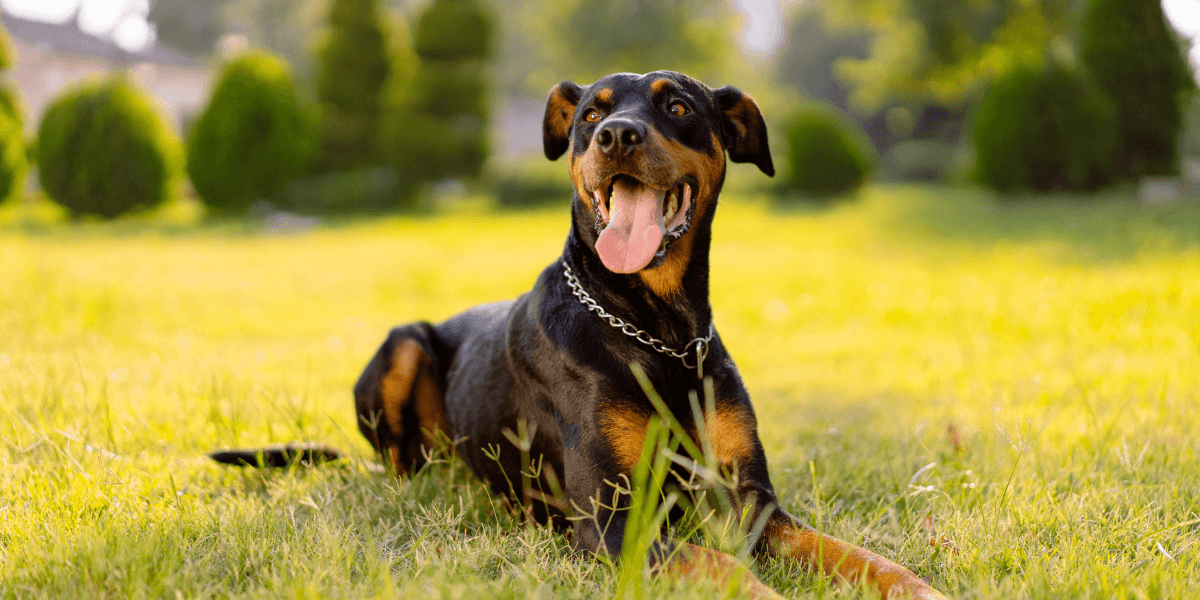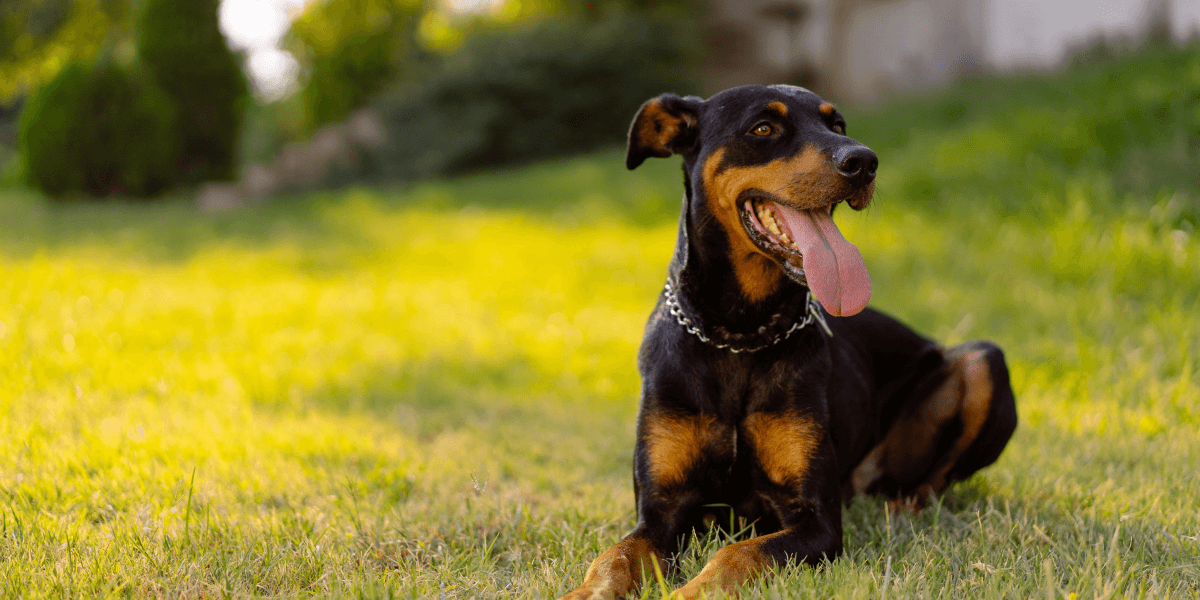Introduction
Rottweiler vs. Doberman: Selecting a loyal, intelligent, and protective.
- Rottweilers and Dobermans are known for their strength and protective instincts
- Both breeds are popular choices for families and individuals
- This post will clarify the differences to help you make an informed choice
1. Breed History and Origins

Rottweiler
Origins:
- Rottweilers trace back to the Roman Empire
- Used by Roman legions for herding and guarding cattle during long marches
- Ancestors of Rottweilers were likely brought to the region of modern-day Germany
- The breed developed into the robust and versatile working dog known today
Purpose:
- They were used for herding livestock, pulling carts laden with butchered meat to market
- Renowned for their strength, endurance, and intelligence
- Rottweilers transitioned into roles as guard dogs and protectors
- They serve in various capacities, including search, and rescue, and as a loyal family companion
Doberman
Origins:
- Dobermann aimed to develop a breed that could provide protection during his collections
- The breed includes a mix of Rottweiler, German Pinscher, Greyhound, and Weimaraner
- They quickly gained popularity for their sleek look and guarding abilities
Purpose:
- Bred for protection and companionship
- Known for their loyalty, intelligence, and trainability
- Prominent in police and military roles, as well as personal protection dogs
- Excel in canine sports, obedience competitions, and search and rescue
2. Physical Characteristics

Rottweiler
- Size: Typically weighs between 80-135 pounds and stands 22-27 inches tall
- Appearance: Muscular build, broad chest, and a distinctive black coat with rust markings
- Personality: Loyal, confident, and protective, known for their calm demeanor
- Exercise Needs: They require daily physical activity to maintain their health
- Training: Responds well to positive reinforcement and consistent training
- Grooming: Minimal grooming is needed, but regular brushing helps manage shedding
- Health: Prone to hip dysplasia, heart issues, and certain cancers. Lifespan
Doberman
- Size: Usually weighs between 60-100 pounds and stands 24-28 inches tall
- Appearance: Sleek, athletic build with a short coat, black, blue, red, or fawn with rust markings
- Personality: Intelligent, alert, and loyal, known for their protective nature
- Exercise Needs: Requires daily vigorous exercise and mental stimulation
- Training: Highly trainable, excels with consistent and positive reinforcement
- Grooming: Low grooming needs, regular brushing to maintain coat health
- Health: Prone to heart issues, hip dysplasia, and hypothyroidism
3. Temperament and Personality

Rottweiler
- Loyalty: Extremely loyal and protective of their family
- Disposition: They can be aloof with strangers but affectionate with owners
- Training: Responds well to positive reinforcement and consistent training
- Temperament: Can be calm indoors but energetic outdoors
- Socialization: Early socialization is key to a well-rounded temperament
- Interaction: Enjoys playing and needs regular interaction to stay happy
Doberman
- Loyalty: Highly loyal, often called "velcro dogs" for their strong attachment to owners
- Disposition: Intelligent, energetic, and alert.
- Training: Needs mental stimulation and thrives with structured training routines
- Temperament: Often confident and eager to please
- Socialization: Early exposure to various environments helps them remain balanced
- Interaction: Enjoys physical activities and benefits from regular playtime
4. Exercise and Activity Levels

Rottweiler
- Exercise Needs: Requires moderate to high levels of exercise. Daily walks and playtime are essential
- Activities: Enjoys activities like obedience training, agility, and herding
- Mental Stimulation: Benefits from puzzle toys and interactive games
- Exercise Variety: Loves both structured exercise and free play in a safe area
- Social Interaction: Thrives with family playtime and group activities.
- Endurance: Can handle long walks and vigorous play sessions.
Doberman
- Exercise Needs: High energy and requires vigorous exercise
- Activities: Excels in agility, obedience competitions, and protection training
- Mental Stimulation: Thrives with challenging tasks and problem-solving activities
- Exercise Variety: Enjoys running and active play in secure areas
- Training: Benefits from engaging in training sessions to stay mentally and physically fit
- Activity Level: Requires consistent exercise to avoid boredom and restlessness
Don’t miss our guide on 10 Must Know Tips for Caring for a German Shepherd Puppy for insights into raising another loyal and intelligent breed.
5. Health and Lifespan

Rottweiler
- Common Health Issues: Prone to hip dysplasia, elbow dysplasia, and certain heart conditions
- Lifespan: Typically lives 8-10 years
- Regular vet checkups: Crucial for early detection of health issues.
- Maintain a healthy weight: To prevent joint problems and other ailments
- Monitor for signs of arthritis: Common in older Rottweilers.
Doberman
- Common Health Issues: Susceptible to dilated cardiomyopathy, hip dysplasia, and von Willebrand’s disease
- Lifespan: Generally, lives 10-13 years
- Regular vet checkups: Help catch potential health problems early
- Maintain a healthy weight: Key to a Doberman's overall health
- Watch for symptoms of heart issues: Such as fatigue or coughing
Check out these Essential Tips for Dog Nutrition for a healthier, happier pet.
6. Grooming and Maintenance

Rottweiler
- Coat Care: Has a short, dense coat that requires regular brushing to minimize shedding
- Maintenance: Needs regular baths and routine nail trimming, ear cleaning, and dental care
- Shedding: Moderate shedding, especially during seasonal changes
- Skin Care: Check for skin irritations or hotspots regularly
Doberman
- Coat Care: Also has a short coat that is low-maintenance but benefits from regular brushing
- Maintenance: Needs regular grooming, including baths, nail trimming, and ear cleaning, to stay sleek
- Shedding: Minimal shedding, but regular brushing helps reduce loose hairs
- Skin Care: Monitor for skin conditions or rashes, especially in summer
7. Family and Home Suitability

Rottweiler
- Family Dynamics: Good with families and kids but needs supervision due to their size and strength
- Living Space: Adaptable to various living situations but thrives best with a yard to play in
- Interaction: Enjoys family activities and can be a playful companion for children
- Safety: Strong protective instincts make them excellent watchdogs
Doberman
- Family Dynamics: Great with families and forms strong bonds with kids, known for their protective nature
- Living Space: Needs ample space to run and play, making them better suited for homes with yards
- Interaction: Highly social and enjoys being part of family events and activities
- Safety: Their alertness and loyalty provide a strong sense of security
Learn more about how other breed adapt to family life and their interactions with kids and other pets in our detailed guide: Dobermans and Family Life.
FAQs
1. Which breed is more suited for apartment living?
- Dobermans adapt better to apartment living with adequate exercise
2. Do Rottweilers or Dobermans have better temperaments?
- Both are loyal and intelligent, but Rottweilers are more laid-back
3. Which breed is more prone to health issues?
- Dobermans often have more genetic health problems compared to Rottweilers
4. Are Rottweilers or Dobermans better guard dogs?
- Both excel as guard dogs, but Rottweilers have a stronger guarding instinct
5. Which breed has a longer lifespan?
- Dobermans generally live longer, averaging 10-13 years, compared to Rottweilers' 8-10 years
6. Which breed is more suitable for active owners?
- Dobermans are more suited for active owners due to their high energy levels
7. How do the grooming needs compare?
- Both breeds have low grooming needs, but Rottweilers shed more than Dobermans
Conclusion
- Choose the breed that best fits your lifestyle and needs
- Both breeds offer loyalty and protection, but consider their traits carefully
- Evaluate their characteristics to find the perfect match for your family
- Understanding their differences helps you select the ideal companion
- Think about grooming needs and maintenance for your lifestyle
- If this post was helpful, share it with friends and family considering these breeds
References
Check out these reputable sources:
- The Best Joint Supplements for Dogs with Hip and Joint Pain https://www.eachpaw.com/a/blog/joint-supplements-for-dogs
- German Shepherd Dog Breed https://www.eachpaw.com/a/blog/german-shepherd-dog-breed-overview
- American Kennel Club - Rottweiler
- https://www.akc.org/dog-breeds/rottweiler/
- American Kennel Club - Doberman Pinscher https://www.akc.org/dog-breeds/doberman-pinscher/
- Rottweiler Health Foundation
- https://rottweilerhealth.org/
- Doberman Pinscher Club of America
- https://dpca.org/



